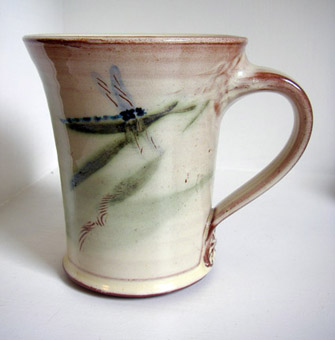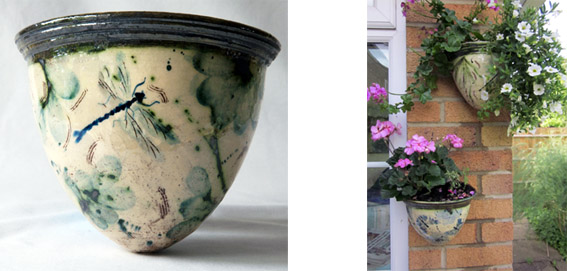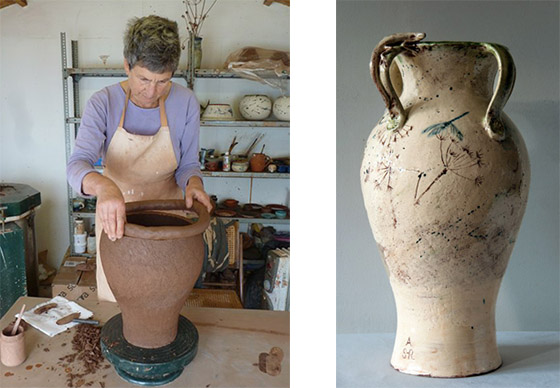
A few words about some of my pots
I like the finished pot to retain the feel of the clay from which it was made. And I like the combination of conscious design and randomness, to which the art of making pots lends itself. The random effect (although controlled to some extent by me) is obtained by the movement of dipping the pot at leather-hard stage in the bucket of white slip (liquid clay). The "seascape" design of the mugs and jugs particularly is a result of this movement. I aim for the red colour of the clay to partially show through the white slip.
The Clay
I use red earthenware clay which comes from the traditional pottery town of Stoke on Trent. There is a massive seam of this red clay stretching from Wales to Staffordshire. This clay is so close to the surface that many years ago the farmers used to make their own butter pots - just pinch pots that were wood fired in the ground - in order to take their butter to market. It is still dug from two quarries in Newcastle-under-Lyme and Longton.

Decoration
The painting on my pots is done with Chinese brushes. Most of my inspiration is from the natural world, sometimes creatures such as butterflies and dragonflies, sometimes the details of natural patterns and forms, not necessarily realistic.


Colour
The colours I use come from copper and iron oxides, and cobalt carbonate. People very often comment favourably on my colour palette. I'm sure this is because these earth colours are subtle and gentle. I blend these three colours which gives both unity and variety to the pots. I also use a tiny bit of Persian turquoise for the centre of bowls.

Bowls
I make all kinds of bowls - pasta bowls, side salad bowls, dessert bowls, soup bowls and larger fruit and salad bowls. Also very tiny bowls which I gather from my customers serve a multitude of uses - earring holders, ring holders while washing up is being done, oil, salt, essential oils for aromatherapists... They are also being used in a church to hold special communion wafers for people with gluten allergy.


The lizard design: the inspiration for this came while I was on holiday on a very small and dry Greek island. Sitting by a tiny natural pool in the mountains I watched as many lizards darted out from the rocks and bushes to drink at the pool.
Olive dishes
I make double and triple olive dishes. The triple ones are actually made from four little bowls, one of which is cut up when still wet to form the curved handle.


Porte-cuillères
As the name suggests, this is an idea from French pottery. It means literally, spoon carrier, designed for the kitchen wall to hold all those wooden spoons and other utensils. Also useful for dried herbs. It can also hold water. Some customers have used them as toothbrush holders in the bathroom. Not for outdoor use.
Wall-hanging planters
These are designed for outdoor or conservatory use. They have a drainage hole so are suitable for direct planting. They are frostproof (although this is not an absolute guarantee) because firstly they are high-fired (1125 degrees centigrade) and secondly are glazed all round which prevents water from entering the clay body. (It is the expansion of water in the clay when it freezes that can cause pots to crack in freezing conditions.)

Coil pots
I also love making pots by the coiling method - the oldest method of creating pots. I use thick coils and build the pots up bit by bit with a mixture of coiling and pinching and scraping. This method is very slow (compared to throwing on the wheel) and the finished pots have a very different feel to them.

